Our expert takes an honest look at the pros and cons of air source heat pumps
Air source heat pumps are now one of the leading low-carbon heating choices for homes. Our expert David Hilton guides you through everything you need to know about them
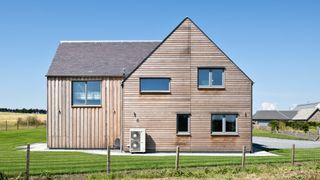
Air source heat pumps are soon to be mandatory in all new build homes, with the government's Future Homes Standard exploring two options, both of which will see the low-carbon heating option required to be installed by law.
Existing homes will also be increasingly likely to adopt heat pumps with the government looking to roll out a gas and oil boiler ban by 2035 and offering homeowners up to £7,500 through its Boiler Upgrade Scheme. However, as appealing as that might sound, it is not always a straightforward swap.
Installing an air source heat pump will ideally require improvements to the fabric of a home to operate efficiently. But once this is achieved, air source heat pumps are hard to beat when it comes to producing renewable heating.
Our heating expert David Hilton takes an honest look at all the pros and cons of air source heat pumps so you can assess whether one makes sense in your project.
Air source heat pumps
An air source heat pump is a low-carbon heating source. It uses a refrigeration cycle to move heat from the air outside and transfers it as useable heat in your home.
Air source heat pumps, like boilers, are a heat source, but they deliver lower temperatures than a boiler. As such, they ideally need to be carefully designed into well-insulated, airtight homes to ensure optimum efficiency.
However, heat pumps work very differently to boilers in that they don't create heat — instead they move heat from one place to another through the vapour compression cycle (or refrigeration process) to make it useable.
There are two main types of air source heat pump:
- Air to water heat pumps are used in wet central heating systems to heat radiators, underfloor heating and sometimes to generate hot water.
- Air to air heat pumps are perhaps better known as air conditioning, and heat the air directly. This will include some level of air movement and noise as you'd expect from an air conditioning unit.
This article will focus on air to water heat pumps. These work by heat being absorbed into a fluid from the air, which causes it to ‘boil’ and become a gas. The gas is then compressed, raising its temperature. The higher temperature is then transferred into the heating system (i.e. the radiators or underfloor heating).
The efficiency of a heat pump, or rather the measure of the heat energy output per kW of electricity, is stated as the COP (Coefficient of Performance) or SCOP (Seasonal Coefficient of Performance). The SCOP is the average COP over a defined period of time, such as a year. For example, a SCOP of 3.2 means that for every 1kW of electricity, 3.2kW of heat is generated.
It is also worth noting that air source heat pumps need electricity to power them. This can be from the grid or from renewable energy sources such as solar panels (ideally with solar battery storage), assuming it can generate the required amount of power.
Pros of air source heat pumps
It is essential to design and specify the system correctly. When it comes to knowing is my home suitable for a heat pump, ideally the insulation, airtightness and emitters (typically underfloor heating or carefully sized radiators) of the property should be optimised to allow you to get the most out of your air source heat pump.
There are many benefits to installing an air source heat pump, including:
- Unlike a gas boiler, an air source heat pump does not produce carbon when operating. While they do use electricity, ASHPs can be combined with solar PV panels or a renewable/green energy tariff for clean electricity.
- In the right context, air source heat pumps have comparatively low running costs, especially when compared with off-grid fuels such as propane, oil or direct electric heating. The cost of installing an air source heat pump will depend on the complexity of the install, alongside factors such as the distance from the heat pump unit, as well as whether or not the homeowner can take advantage of grants such as the Boiler Upgrade Scheme.
- The outdoor unit takes up less space when compared to an above-ground oil or LPG tank.
- Air source heat pumps partner well with underfloor heating.
- There are certain grants available to offset the costs of installing an air source heat pump, such as the Boiler Upgrade Scheme.
- Some models can also be used for cooling a home, but you will need to weigh up heat pumps vs air conditioning before opting for this solution.
Cons of air source heat pumps
While there are many benefits, there are also some cons too, including:
- They are not a ‘one-size-fits-all’ solution and may not be suitable for every home in the same way as gas boilers are. They're ideally paired with well-insulated, airtight homes.
- Installing an air source heat pump in an existing home is more complex and replacing a gas boiler will inevitably be much more expensive than a like-for-like replacement.
- Electricity is still needed to power an air source heat pump, so they are not entirely 'renewable' unless paired with PV panels or a renewable energy tariff.
- Electricity prices are currently high. Campaigners are asking the government to move environmental levies off electricity bills, with the focus on air source heat pumps, to ensure that it's always cheaper to run a heat pump than a gas boiler.
- The bigger the difference between the outside air and the target temperature (either the indoor room temperature or domestic hot water), the lower the efficiency.
- A separate solution may be required for providing hot water for the home.
- If you want to know are air source heat pumps noisy, some may reach 40 to 60 decibels, but this depends on the manufacturer and installation, according to Quiet Mark, which certifies the quietest heat pumps.
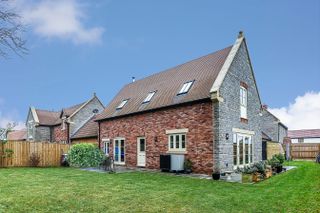
Using an ASHP for heating and hot water
One of the key decisions to make when buying an air source heat pump is whether it will provide space heating or domestic hot water — or both.
The ‘flow temperature’ (the temperature of the water in the heating system) is lower in a heat pump than it is in a boiler. This means:
- Space heating will usually require a flow temperature of around 35°C to 45°C for underfloor heating or low-temperature radiators.
- Domestic hot water will, however, require a minimum flow temperature of 55°C.
On new homes that meet recent and current Building Regulations, most air source heat pumps can do both, but this is not always the case.
Having two heat pumps as a solution
One solution is to use two heat pumps: one that is optimised for the space heating and another for domestic hot water.
The advantages of using the two heat pumps is that each unit is optimised for the required flow temperature and there is no priority system that causes the space heating circuit to ‘cool’ while the domestic hot water is being reheated.
The domestic hot water heat pump typically uses a different refrigerant that can produce higher flow temperatures but also requires a higher source temperature (10°C) to be efficient.
It tends to be lot smaller than a space heating heat pump and is usually built into the hot water cylinder. It draws its air from the room it is in, or the kitchen or bathroom (or all of them) or from the exhaust waste heat of a ducted mechanical ventilation system — and is known as an ‘exhaust air heat pump’ or a ‘micro heat pump’.
It is crucial that this system is designed properly so as to not over ventilate the property and only uses heat from the air that would normally have been exhausted to atmosphere.
Having a high temperature heat pump
A further option is a high temperature heat pump. There are different variants available, but these could offer temperatures of 60-80°C.
In order to achieve higher temperatures, some manufacturers have built the two different refrigerant systems into one heat pump in a ‘cascade’ system that can create flow temperatures of up to 80°C.
These systems are designed for hot water and should not really be used as a high temperature boiler replacement unless the lower efficiency has been carefully calculated to ensure that it is the best option for the property. In other words, they're best suited to well-insulated, airtight homes.
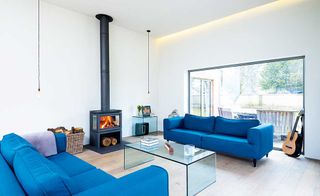
Assessing whether to install an ASHP
An air source heat pump for a new home
The efficiency of an air source heat pump is dependent on a number of factors, including the fabric of your home. In a new build, especially one that has been built with fabric first principles at the forefront, equipping your home with an air source heat pump is definitely worth considering. Not only do they offer low carbon heating for your home, they're also reliable and last much longer than a gas boiler.
Air source heat pumps do not tend to go wrong too often either, and a good quality air source heat pump could last up to 20 years. Pair that with the potential to regain some of the initial expense through the Boiler Upgrade Scheme, and it's a worthwhile investment in the future of your home.
An air source heat pump for an existing home
Hybrid heat pumps are also available, which combine an air source heat pump and gas boiler together in one box, designed to work in partnership and get the best from each heating system.
Should I swap my boiler for an air source heat pump? is a popular question at present. It's not as simple as it sounds to switch, and deciding to retrofit an air source heat pump in an existing home will mean certain changes will need to be made.
A boiler works at a high flow temperature of around 70°C, but an air source heat pump operates at a lower temperature — around 35°C to 45°C for the radiator system and around 55°C for hot water.
Unless your home's current radiators are over-specified, it's likely you'll need to replace radiators with new ones that have a higher output, alongside room by room controls and a heat pump-compatible hot water storage.
The lower temperatures will also mean that an air source heat pump is ideally compatible with homes that have high levels of insulation and airtightness.
The levels of insulation and airtightness are often not optimised in older properties. This would cause the heat pump to operate at increased flow temperatures, resulting in lower efficiency and higher running costs. This will mean added cost in remedying these immediate fabric issues before installing an air source heat pump.
"The problem homebuilders and government bodies are facing is the way we have historically built our homes. The 1970s era of homebuilding ignored fabric heat loss as gas was cheap, which led to the installation of gas central heating," says Keith Bastian, CEO of renewable home heating provider Fischer Future Heat.
"This building approach has put us an a big disadvantage to install heat pumps," continues Keith. "A house that is poorly insulated will require a larger heat pump to make up for heat loss, and this could cost more money to install and to run."
Finally, when weighing up a heat pump vs a gas boiler in an existing home, an air source heat pump may actually cost more to run (though is much more sustainable), so when it comes to retrofitting a heat pump, it's often more attractive when replacing a more expensive heating system such as electric heating.

Keith has more than 25 years of experience in the heating industry, bringing German manufactured electric heating to the UK in 2009 through his company Fischer Future Heat. The company has now installed over 250,000 heaters in UK homes.
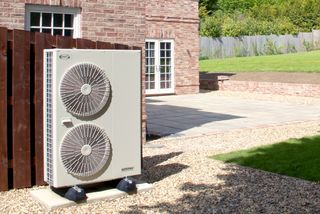
Checklist for whether to install an ASHP
There are some key criteria your home will need to meet to make installing an air source heat pump viable, including:
1. Do you have enough space for one to be installed? You'll need to have space for a unit to be attached to a wall or fitted on the ground, with space around it to ensure a good airflow. For an air source heat pump to be installed under Permitted Development, it also needs to be located at least one metre from the boundary of the house. The internal unit for an air source heat pump is generally smaller than a gas boiler. However, you will need space for a hot water cylinder, if you do not have one already, and controls.
2. What heating system will you use? The big question: do air source heat pumps work with radiators? For space heating, air source heat pumps work best with underfloor heating, but low-flow temperature radiators, such as oversized radiators, multi-finned aluminium radiators or fan convectors, will work as well. In existing homes, this might require you to upgrade the radiators you already have.
3. How well insulated is your home? Air source heat pumps work more efficiently when producing heat at a lower temperature, so a home that requires less space heating because it is better insulated is key to getting the most from this technology.
4. What system are you replacing? The initial expenditure of an air source heat pump is high, even with a government-funded grant helping claw back some of the outlay. Air source heat pumps are much more cost-effective to install in a new home, as the pipework and emitters will be designed around them from the outset. In an existing home, the installation may necessitate work to the existing heating system.
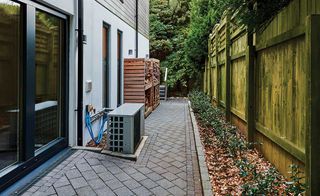
FAQs
How long does it take to install an ASHP?
Air source heat pump installation is a relatively low-disruption process which could take as little as a single day to undertake.
A solid base for the air source heat pump should be constructed and, when retrofitting, all alterations to the fabric of the house and radiator systems should be completed before the installation date.
An air source heat pump should be installed and commissioned by an accredited Microgeneration Certification scheme (MCS) installer. An incorrectly commissioned air source heat pump may use a lot more electricity.
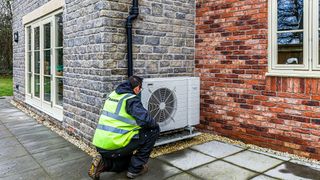
Do air source heat pumps work in winter?
Do air source heat pumps work in cold weather? An air source heat pump gets its energy from the surrounding air, so as the ambient air temperature drops, so does the efficiency. It is therefore key to understand the heat load of the property and the performance characteristics of the heat pump.
When it gets closer to zero degrees outside, the air source heat pump will also need to perform a defrost cycle more often and this will also lower the efficiency.
However, while the efficiency may drop, that doesn't mean that air source heat pumps don't work in cold weather. It's been found that they can extract heat from the air in temperatures as low as -20°C, and are used in cold climates around the world.
For more information on living with an air source heat pump, read my Mitsubishi Ecodan 11.2kw heat pump review and find out how to maintain a heat pump. Or, if you're looking for an alternative to a gas boiler, but don't think an air source heat pump is right for your home, there are many other systems you could investigate, including ground source heat pumps, a biomass boiler, solar thermal and hydrogen heating.
Get the Homebuilding & Renovating Newsletter
Bring your dream home to life with expert advice, how to guides and design inspiration. Sign up for our newsletter and get two free tickets to a Homebuilding & Renovating Show near you.
David is a renewables and ventilation installer, with over 35 years experience, and is a long-standing contributor to Homebuilding and Renovating magazine. He is a member of the Gas Safe Register, has a Masters degree in Sustainable Architecture, and is an authority in sustainable building and energy efficiency, with extensive knowledge in building fabrics, heat recovery ventilation, renewables, and also conventional heating systems. He is also a speaker at the Homebuilding & Renovating Show.
Passionate about healthy, efficient homes, he is director of Heat and Energy Ltd. He works with architects, builders, self builders and renovators, and designs and project manages the installation of ventilation and heating systems to achieve the most energy efficient and cost effective outcome for every home.